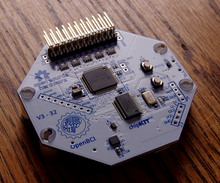OpenBCI: Difference between revisions
Spelling/grammar correction |
Updated image caption |
||
| Line 1: | Line 1: | ||
{{Orphan|date=December 2014}} |
{{Orphan|date=December 2014}} |
||
[[File:Openbci-brain-computer-interface-by-omphalosskeptic.png|thumb| |
[[File:Openbci-brain-computer-interface-by-omphalosskeptic.png|thumb|OpenBCI Board]] |
||
'''OpenBCI''' is an [[open source]] brain-computer interface. The OpenBCI was developed by Joel Murphy and Conor Russomanno, and crowd-funded by a successful Kickstarter campaign. The final product began shipping in November 2014, ten months after the end of the funding period. |
'''OpenBCI''' is an [[open source]] brain-computer interface. The OpenBCI was developed by Joel Murphy and Conor Russomanno, and crowd-funded by a successful Kickstarter campaign. The final product began shipping in November 2014, ten months after the end of the funding period. |
||
The OpenBCI can be used to measure and record electrical activity produced in the brain ([[EEG]]), muscles ([[EMG]]), and heart ([[EKG]]), and is compatible with standard EEG electrodes. The OpenBCI can be used with its own display and processing software, or it integrated with other open-source EEG software suites. |
The OpenBCI can be used to measure and record electrical activity produced in the brain ([[EEG]]), muscles ([[EMG]]), and heart ([[EKG]]), and is compatible with standard EEG electrodes. The OpenBCI can be used with its own display and processing software, or itcan beintegrated with other open-source EEG software suites. |
||
== Hardware == |
== Hardware == |
||
Revision as of 05:42, 27 December 2014

OpenBCIis anopen sourcebrain-computer interface. The OpenBCI was developed by Joel Murphy and Conor Russomanno, and crowd-funded by a successful Kickstarter campaign. The final product began shipping in November 2014, ten months after the end of the funding period.
The OpenBCI can be used to measure and record electrical activity produced in the brain (EEG), muscles (EMG), and heart (EKG), and is compatible with standard EEG electrodes. The OpenBCI can be used with its own display and processing software, or it can be integrated with other open-source EEG software suites.
Hardware
The OpenBCI uses an ADS1299 analog-digital converterICdeveloped byTexas Instruments.[1]The OpenBCI uses amicrocontrollerfor on-board processing — the 8bit version uses anArduino-compatible ATmega328P IC, while the 32bit board uses aPICmicrocontroller — and can write the EEG data to an SD card, or transmit it to software on a computer over abluetoothlink.
Software
Currently, OpenBCI has released an open-source application for use with the OpenBCI, written withProcessing.Display and processing software written inNodeJSandPythonare are also being developed.
3D Printed Headset
Design files for a3D printedheadset for the OpenBCI, dubbed the Spiderclaw 3000, have been released. The headset holds the electrodes in place, and make it easy to configure their placement using the10–20 System.So far, only the files for the pre-production OpenBCI boards — version one and two — have been released. The headset design compatible with the final iteration of the boards is scheduled to be completed in December 2014.
References
- ^Cohen, Reuven (2014-03-01)."New Open Source Platform Allows Anyone To Hack Brain Waves".Forbes.Forbes Media.Retrieved2014-12-16.
